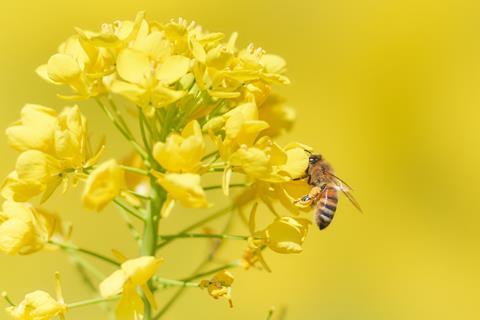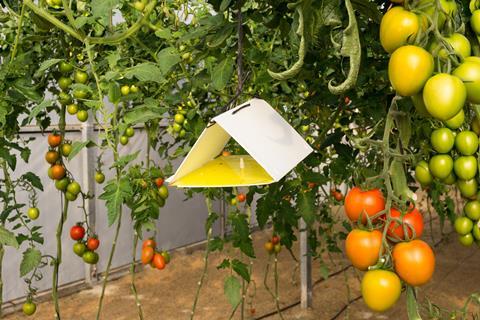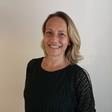Discover the pesticides scientists are developing to guarantee future food production
The world’s population is expected to grow from about 8 billion in 2022 to 9.7 billion by 2050. Providing enough to feed so many mouths is one of the greatest challenges we face.
Pesticides play an important role in boosting agricultural productivity and their use has increased steadily over time. But these agrochemicals can have adverse impacts on human health and the environment, including bees, birds and aquatic organisms. To make matters worse, as pests become resistant to existing pesticides, farmers in some regions are forced to use higher concentrations per treated area.
The high cost of conventional chemical synthesis means it is rarely used for lower-value crops
The full environmental impact of new agrochemicals often only becomes evident after years in the field. For example, when neonicotinoids were first launched, they were thought to be safer and greener than existing substances. But in recent years neonicotinoids have hit the headlines because of their unforeseen adverse effects on bees. They are systemic pesticides, which means they are taken up by a plant and transported to all its tissues, flowers, pollen and nectar. They act on nicotinic acetylcholine receptors in crop-devouring insects but they also disrupt bees’ sense of orientation, memory and reproduction.
In 2018, the EU banned all outdoor use of four commonly used neonicotinoids, with some exemptions. In January 2023, the European Court of Justice ruled that member states can no longer grant derogations, for example for treating seeds. In the UK, the government still permits farmers to use the substances on sugar beet crops.

In 2015, the EU approved flupyradifurone and sulfoxaflor as next generation insecticides, although they too act on nicotinic acetylcholine receptors. They were originally thought to be safe for bees, but in 2022 the European Commission decided to ban outdoor use of sulfoxaflor because it could not rule out a risk. A study in Germany found that flupyradifurone and sulfoxaflor can affect insects’ intestinal flora, making them more susceptible to disease and shortening their lifespan, especially when used with a common fungicide.
In your class
Population growth and food security are incredibly important topics that will affect learners’ lives. Make cross-curricular links to biology and geography while discussing the chemistry involved in overcoming global issues and how agricultural solutions might not always be as straightforward as they seem.
Moth mimics
There is a push to switch to alternative forms of crop protection to boost agricultural production while cutting levels of harmful pesticides.
In June 2022, the European Commission adopted proposals for a new Sustainable Use of Pesticides Regulation (SUR). Although beset by delays, the regulation will include EU-wide targets to halve the use of chemical pesticides by 2030, compared with 2015 levels. The SUR will require farmers to use ‘integrated pest management’, prioritising alternative methods such as biological controls, including using beneficial insects, fungi or bacteria.

An increasingly popular alternative is to use synthetic pheromones to disrupt the mating behaviour of certain pests. Insects use pheromones to communicate when seeking a mate. By releasing synthetic copies via dispensers next to crops it is possible to confuse male insects and disrupt their ability to locate female partners. The pheromones are relatively species-specific and do not affect other insects.
Synthetic pheromones have been used successfully to control insects such as the codling moth, which is partial to apple and pear trees. They are also effective against other moths such as the diamondback, which attacks Brassica crops, including cabbage, broccoli and cauliflower.
Researchers are using plants to ‘grow’ pheromones
They built new DNA sequences based on moth genes and transplanted them into the tobacco plants
However, although pheromone-based pest control is used for expensive crops, the high cost of conventional chemical synthesis means it is rarely used for lower-value crops such as soya beans, maize and cotton.
Plant factories
As well as being expensive, large-scale chemical synthesis brings an added risk of toxic by-products, so researchers are using plants to ‘grow’ pheromones. They do this by studying the genes of a certain pest to find out which are responsible for producing pheromones and then transplanting them into plants.
At the Earlham Institute in Norwich, for example, Nicola Patron and her team have turned tobacco plants into factories for moth pheromones. They built new DNA sequences based on moth genes and transplanted them into the tobacco plants. ‘Plants produce an array of useful molecules already so we’re able to use the latest techniques to adapt and refine the existing machinery,’ says Nicola.
In the future there may be greenhouses full of plant factories, ‘providing a greener, cheaper and more sustainable way to manufacture complex molecules’
They add copper sulfate to tune the genetic activity to make sure the plants don’t use their energy for producing pheromones but have enough left to grow healthily. The team are now extracting the plant-made pheromones and testing them in dispensers to see how well they trick male moths. Nicola predicts that in the future there may be greenhouses full of plant factories, ‘providing a greener, cheaper and more sustainable way to manufacture complex molecules’.
In 2022, international researchers used oilseed plants to create pheromone precursors. They engineered Camelina plants to make a hexadecenoic acid precursor to the pheromones produced by two types of caterpillars that feast on a wide variety of crop plants. They planted a small field with the engineered plants, processed the seeds, extracted the precursor and transformed it into pheromones at low cost. When they tried the pheromones at agricultural test sites, they worked as well as commercially made versions but at a much lower cost.

Download this
Pesticides and agricultural productivity calculations, for age range 14–16
Provide context to your learners while developing their mathematical skills.
Resources include:
Download this
Pesticides and agricultural productivity calculations, for age range 14–16
Provide context for your learners while developing their mathematical skills.
Download the resources from the Education in Chemistry website: rsc.li/3PzCgDw
Fungal fight
Some new pesticides are based on endophytic fungi, which live inside plant tissues without causing symptoms of infection or disease. When they colonise a plant, endophytic fungi help their hosts perform better under stressful environmental conditions and some produce metabolites that can fight off pests. Scientists have found the metabolites to be a rich source of active ingredients for pharmaceuticals and agrochemicals.
Researchers in Kenya inoculated tomato plants with fungi to fight leafminer pests, which bore into leaves, fruits and flowers, devastating crops and causing significant economic damage. Leafmining species have developed increased resistance to synthetic pesticides so there is a need for alternative control methods. They tried out a range of fungi but one in particular killed the pests after 15 days.
Mojgan Rabiey and colleagues at the University of Birmingham’s School of Biosciences are studying endophytes that colonise crops such as wheat and barley to protect them against bacterial pathogens. The team collects environmental samples before isolating the naturally occurring endophytes and testing them against bacterial pathogens in the lab. ‘There are lots of studies in vitro but not many have been conducted in the environment because you need lots of data to show that the endophytes are safe before you can use them in the field,’ says Mojgan.
As well as studying endophytes, Mojgan is interested in using viruses called bacteriophages to fight bacterial infections in plants and trees, especially those causing cankers in trees such as cherry, horse chestnut and ash. For cherry canker, there is no treatment and often the only option is to cut down infected trees. ‘We try to understand if we can isolate phages from the environment and infect pathogens. We could use them as biological control agents because they are very host specific and they don’t affect other beneficial microbes,’ says Mojgan. They could be applied as simple sprays, she adds.
More resources
- Improve learners’ data handling with a worksheet on number lines and fill-in-the-blank questions when rounding and calculating significant figures in chemistry.
- Use the resource accompanying a 7 simple rules article on reducing cognitive load to build knowledge for ideas on modelling worked examples and fading scaffolding.
- Link your teaching of pesticides and agricultural productivity to careers with Emma’s job profile as a pollution control officer.
- Review moles, yields, atom economy and titrations with your 16–18 learners using the Starter for 10: quantitative chemistry.
More resources
- Improve learners’ data handling with a worksheet on number lines and fill-in-the-blank questions when rounding and calculating significant figures in chemistry: rsc.li/46npGgl
- Read the article, ’Reduce cognitive load to build knowledge’ and use the accompanying resource to model worked examples and fade scaffolding: rsc.li/44lCHoZ
- Link your teaching of pesticides and agricultural productivity to careers with this profile of Emma, a pollution control officer: rsc.li/46sUc8u
- Review moles, yields, atom economy and titrations with your 16–18 learners using the quantitative chemistry Starter for 10: rsc.li/3pvodnx
Essential oils
Other options for alternative pesticides include plant extracts and essential oils. These have the benefit of being biodegradable, although many are far from harmless. For example, pyrethrum – a natural insecticide derived from the flowers of Dalmatian and Persian chrysanthemums – has been used for centuries as an insecticide. The flowers look like giant daisies, but their yellow centres contain pyrethrins, which target the nervous system of insects, with devastating effects. The insecticide is less toxic to mammals and birds than many synthetic pesticides but is still known to be very toxic to aquatic life.

Meanwhile, an insecticide called rotenone occurs naturally in seeds and stems of several plants, including the jicama vine plant. Rotenone was first used in the 1800s for killing leaf-eating caterpillars and has been one of the most widely used insecticides. But epidemiological evidence suggests it may be a risk factor for Parkinson’s disease. Rotenone insecticides were banned in the UK in 2009 and are being phased out in the US and Canada.
Essential oils are mainly composed of terpenoids and phenylpropanoids. Thymol from thyme oil is particularly toxic to insects, such as varroa mites which attack honeybees. Meanwhile, eugenol, extracted from cloves, nutmeg and cinnamon, can help to fight weevils. Studies suggest it may inhibit the actions of an enzyme that hydrolyses the neurotransmitter acetylcholine.
Another neurotransmitter affected by essential oils is octopamine, which is involved in several biological processes. Brazilian researchers found that terpenoid constituents of cinnamon and clove essential oils produce muscle contractions in the legs and abdomen of granary weevils, associated with blocking octopamine receptor binding sites.
It seems there is no perfect option for keeping pests away from the crops we need to fuel a rapidly growing global population. However, we can cut future pesticide use by combining different biological controls.
Article by Hayley Bennett, a science writer and editor based in Bristol, UK. Resource by Harry Lord, head of year at Haslingden High















No comments yet